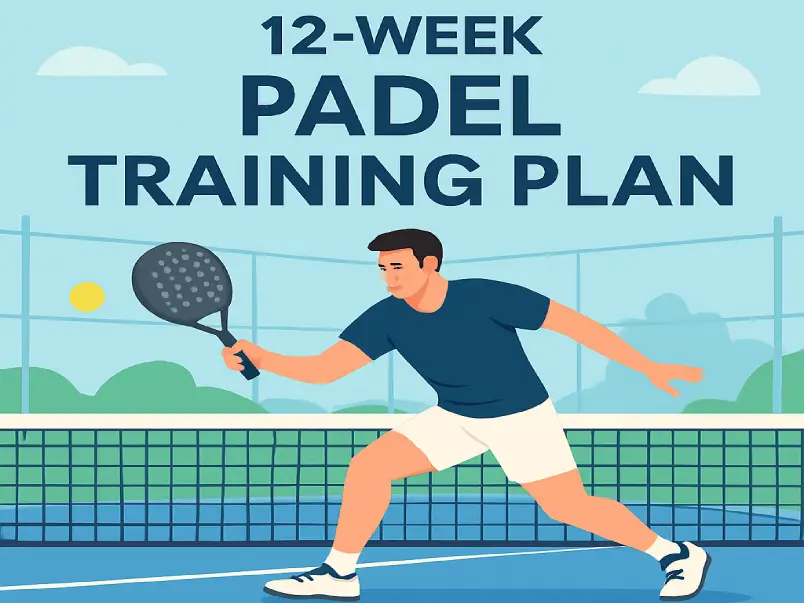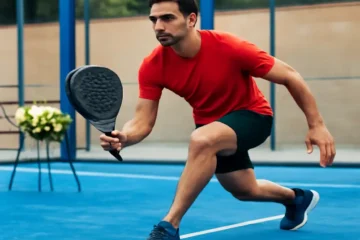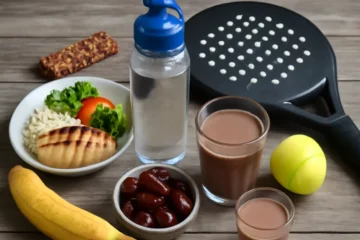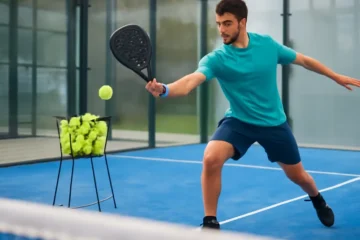If you’ve ever felt stuck in your padel progress—missing the same volleys, losing points you know you could have won, or feeling unsure how to train smarter—you’re not alone. Many players hit a plateau simply because they lack structure. The truth is, improvement in padel doesn’t happen by chance; it comes from a systematic, progressive approach that builds every area of your game — technical, tactical, physical, and mental.
Welcome to The Ultimate 12-Week Padel Training Plan — your roadmap to transforming how you train, play, and think on the court. Whether you’re a beginner, an intermediate player, or returning after a break, this plan gives you a clear path from fundamentals to match dominance.
Section 1: Before You Begin — Laying the Groundwork
Before diving into drills and matches, it’s essential to understand where you stand and where you want to go. The foundation of improvement is self-awareness and preparation.
1.1 Assessing Your Current Level
Start by asking yourself a few honest questions:
- How consistent are my groundstrokes and volleys?
- Can I control the ball off the glass confidently?
- How is my reaction time at the net?
- Do I understand basic positioning and court coverage?
Take it a step further — record a short match or training session. Watching yourself play can reveal more than you realize: positioning errors, timing issues, or weak transitions between shots.
This initial assessment will help you set realistic goals and track progress later in the program.
1.2 Defining Your “Why” — Setting SMART Goals
Improvement without direction leads to frustration. Define your “why” — the reason you’re committing to these 12 weeks.
Use the SMART method:
Specific, Measurable, Achievable, Relevant, and Time-bound.
Examples:
- “Win two matches in my local padel league by week 12.”
- “Develop a consistent bandeja and volley combination.”
- “Increase my net reaction speed by 20%.”
These goals will serve as your motivation checkpoints throughout the plan.
1.3 Essential Gear & Preparation
Before starting, make sure you have the right equipment to support your progress:
- A balanced padel racket that matches your level and playing style.
- Proper padel shoes with good grip and lateral stability.
- Quality balls and comfortable, breathable clothing.
And remember — your body is your most important tool. Always begin each session with a dynamic warm-up (shoulder rolls, lunges, jumping jacks) and end with cool-down stretches to improve flexibility and prevent injury.
Section 2: The Philosophy of the 12-Week Plan
This training plan is built on the principle of progressive overload — improving one layer at a time so your skills develop naturally and effectively.
It’s divided into three 4-week phases:
- Phase 1 (Weeks 1–4): The Foundation → Focus on technique and consistency.
- Phase 2 (Weeks 5–8): Building Your Game → Add power, tactical awareness, and net control.
- Phase 3 (Weeks 9–12): Mastering the Court → Integrate advanced shots, complex tactics, and match intensity.
You’ll train 2–3 times per week on court, and include 1–2 fitness sessions for conditioning. Rest days are equally vital — recovery fuels performance.
Section 3: The 12-Week Plan Breakdown
Phase 1: The Foundation (Weeks 1–4)
Goal: Build technical consistency and solid mechanics.
At this stage, we focus on mastering the basics: grip, positioning, and core shots. You’ll train precision over power.
Sample Week Structure:
Technical Focus:
- Forehand and backhand control off the glass.
- Consistent rallying with emphasis on depth and direction.
Tactical Focus:
- Learning positioning fundamentals.
- Practicing patient play — keeping the ball in play under control.
Drill of the Week:
“X-Ball Rally” – Cooperate with a partner to rally cross-court 20 shots without an error. Focus on rhythm and consistency.
Fitness Focus:
- Core stability (planks, mountain climbers).
- Leg strength (lunges, squats).
- Aerobic base: 30 minutes of moderate cardio (cycling, jogging).
Mindset Tip:
Don’t rush results. Technical precision now will make advanced play effortless later.
Phase 2: Building Your Game (Weeks 5–8)
Goal: Add power, tactical intelligence, and control at the net.
You’ve built your foundation — now it’s time to get aggressive. This phase sharpens volleys, smashes, and offensive positioning.
Sample Week Structure:
Technical Focus:
- Mastering the volley and bandeja.
- Introduction to overhead control and recovery after the smash.
Tactical Focus:
- “Attack and Defend” drills: alternate between offensive net play and defensive baseline positioning.
- Learn to transition smoothly from defense to offense.
Drill of the Week:
“Two-on-One Net Dominance” – Two players at the net control a rally against one defender. Encourages sharp volleys, quick reactions, and net awareness.
Fitness Focus:
- Plyometric training (box jumps, burpees) for explosive leg power.
- Agility ladder for faster movement.
- Rotational strength exercises (medicine ball throws, Russian twists).
Mindset Tip:
Learn to anticipate your opponent’s shot instead of just reacting. Watch the shoulders and racket face to predict direction.
Phase 3: Mastering the Court (Weeks 9–12)
Goal: Combine all skills — play smarter, faster, and stronger.
In this final phase, your training mimics real match scenarios. You’ll work on advanced techniques, strategic awareness, and mental endurance.
Sample Week Structure:
Technical Focus:
- Master the Vibora (fast, slicing overhead) and Chiquita (soft, low defensive shot).
- Refine drop shots and counter-smashes.
Tactical Focus:
- Practice creating openings with deception.
- Defensive strategies against advanced opponents.
Drill of the Week:
“Conditional Point Play” – You must execute a specific shot (like a bandeja or lob) before winning the point. Encourages tactical thinking and shot selection.
Fitness Focus:
- HIIT (High-Intensity Interval Training) – short bursts of on-court sprinting and recovery to mimic real match intensity.
- Mental endurance through long rally simulations.
Mindset Tip:
Train your focus. Between points, take deep breaths and use visualization to picture successful plays.
Section 4: The Supporting Pillars — Beyond On-Court Drills
A complete padel player isn’t built by court time alone. Off-court fitness, mindset training, and recovery routines are the pillars that sustain high performance.
4.1 The Off-Court Fitness Regimen
Strength Training:
Padel requires rotational power and joint stability. Focus on compound movements:
- Squats and lunges for leg drive.
- Deadlifts and planks for core stability.
- Shoulder presses for racket control.
Speed & Agility Work:
Include cone drills and shuttle runs twice a week. These improve reaction times during fast exchanges at the net.
Flexibility & Mobility:
Padel demands quick changes of direction. Add yoga or mobility routines to improve range of motion and prevent stiffness.
4.2 The Mental Game
In padel, mental strength often decides who wins the final points. Here’s how to train your mind like a pro:
- Develop a Pre-Point Routine:
Take a deep breath, visualize your shot, and commit. This creates consistency under pressure. - Manage Frustration:
Mistakes are part of the process. Instead of reacting emotionally, focus on the next point. - Visualization:
Spend 5 minutes daily imagining successful rallies, perfect volleys, or winning smashes. Visualization primes your brain for real performance.
4.3 Nutrition & Recovery
Performance depends as much on what happens off the court as on it.
Nutrition Tips:
- Eat complex carbs (oats, brown rice, fruit) for energy before training.
- Include lean proteins (chicken, fish, eggs) post-training for muscle recovery.
- Stay hydrated — dehydration kills focus and endurance.
Sleep & Recovery:
- Aim for 7–8 hours of sleep nightly.
- Use active recovery days: light jogging, mobility work, or foam rolling.
Remember — recovery is when your body adapts and grows stronger.
Section 5: How to Measure Your Progress
Tracking progress keeps motivation high and gives you feedback on what’s working.
1. Performance Benchmarks
- Record your rally lengths — can you keep a 20-shot rally consistently?
- Measure your serve speed and accuracy weekly.
- Note improvements in stamina and movement efficiency.
2. Revisit Your Goals
Go back to the SMART goals you set in week 1. Which ones have you achieved? Which still need work?
3. Play a Benchmark Match
At the end of week 12, play against an opponent from your initial session. Compare:
- Shot accuracy and control.
- Decision-making under pressure.
- Fitness and endurance.
You’ll be surprised at how far you’ve come.
Conclusion: Your Path to Match Dominance
Over these 12 weeks, you’ll go from focusing on the basics to mastering advanced tactical and physical aspects of the game. You’ll learn to move smarter, hit cleaner, and think faster.
The real secret to padel mastery isn’t perfection — it’s consistency and commitment. Every hour you dedicate to structured training builds a sharper, more confident version of yourself on the court.
So, grab your racket, step onto the court, and start your journey.
Your ultimate padel game is within reach — and it starts today.
❓ FAQs (SEO-Friendly for Blog Section or Schema Markup)
1. What is a 12-week padel training plan?
A 12-week padel training plan is a structured program designed to progressively improve your technical, tactical, physical, and mental skills on the court. It guides players through weekly drills, fitness sessions, and match simulations to achieve consistent growth and match-ready performance.
2. Who should follow this padel training plan?
This plan is ideal for beginner to intermediate players, or anyone returning to padel after a break. It helps you build solid fundamentals in the first phase and transition into advanced tactics and match play by week 12.
3. How often should I train for padel each week?
For best results, train 2–3 times on court and add 1–2 fitness sessions per week. Include rest or active recovery days to prevent fatigue and allow your body to adapt and strengthen.
4. What are the key skills developed in this 12-week plan?
You’ll improve core skills like volleys, bandeja, vibora, and chiquita shots, while enhancing positioning, shot selection, power, speed, and mental focus. The plan also integrates off-court fitness and recovery to create a complete padel athlete.
5. Do I need special equipment for this padel training plan?
Yes — a well-balanced padel racket, proper padel shoes, quality balls, and comfortable clothing are essential. Always warm up dynamically before training and stretch afterward to prevent injury and improve flexibility.
6. How can I measure progress after 12 weeks?
Track improvements in consistency, accuracy, and fitness. Play a benchmark match against the same opponent you faced before starting the plan — you’ll notice sharper decision-making, stronger strokes, and better match endurance.
7. Can this padel plan help me compete in local tournaments?
Absolutely. By week 12, you’ll not only have stronger fundamentals but also improved tactical awareness and match strategy — essential tools to perform confidently in local or club tournaments.
8. Is this padel training plan suitable for fitness improvement too?
Yes. Alongside technical drills, the plan includes cardio, strength, agility, and HIIT sessions that enhance overall fitness, stamina, and mobility — all crucial for peak on-court performance.




